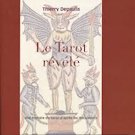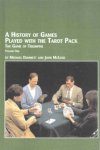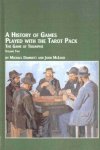Card Games: Tarot Games
Tarot games originated in Italy in the early 15th century. They are still played in a number of European countries, namely: Austria, Czech Republic, Denmark, France, Germany, Hungary, Italy, Romania, Slovakia, Slovenia, Switzerland. Each of these countries has its own rather different version(s) of the game.
Tarot games require special cards - a Tarot pack normally consists of:
- four suits, which may be the French suits of hearts, diamonds, clubs and spades or the Italian suits of cups, coins, batons and swords)
- a series of 21 special cards which serve as trumps
- another special card (looking a bit like a joker, though there is no historical connection) called the fool or excuse.
Tarot was the one of earliest games to introduce the concept of trumps. It is possible that Karnöffel had trumps a few years earlier, but it is probable that Karnöffel trumps were invented independently of Tarot trumps, since they work in a rather different way. In any case, it is clear that virtually all modern trick-taking card games that have trumps inherited the idea ultimately from Tarot games.
Tarot games are point-trick games in which you must trump if you have no card of the suit led. The values of the cards are common to most games of the group: 5, 4, 3, 2 for the court cards in the suits; 5 for the 1 and 21 of trumps and the fool; and 1 for each other card. However, the method of adding up these values in most games is quite unusual and characteristic of Tarot games - see the page on counting points in Tarot games for a discussion.
In "Il Mondo e l'Angelo" (Bibliopolis, Napoli, 1993), Michael Dummett classifies Tarot games into three types. Games of type I, found only in Italy, depart from the usual card values in that besides the fool, 21 and 1 there are other trumps with a value greater than 1 point. This group includes:
- the Florentine game of Minchiate, played with 97 or sometimes 98 cards, which was very popular in central and southern Italy in the 17th and 18th centuries, but seems unfortunately to have died out early in the twentieth century;
- Sicilian Tarocchi, played with a special pack of 63 or 64 cards.
- the forms of Tarocchi played in Bologna with their special 62 card pack. For example Ottocento and Quattro Scartate.
Games of type II and type III use the normal card values: the only counting cards are the fool, trump 21, trump 1 and the four picture cards in each suit. Type II is distinguished from type III by the way that the fool is used. The classic use of the fool is as a card which can be played to any trick instead of following suit or trumping, but loses the trick. It is used this way games of type I, and also in the type II games:
- French Tarot
- Danish Tarok
- Piedomontese games, such as the Tarocchi game played at Piedicavallo
- Troccas (Switzerland: Graubünden)
- Droggn (Tyrol: Stubai valley)
- Tübingen Tarock (Tübingen, Germany 1890-1940 and later)
- Mitigatti (Nice, 1930)
- Abbé de Marolles Tarot (France, 1637)
In Central Europe, the standard card values are still used, but the role of the fool has been changed. It is simply the highest trump (effectively the 22), ranking above the 21. These games in which the fool has its modern role began to appear in the eighteenth century. Michael Dummett classifies them as type III Tarot games.
- Hungarian Tarokk (Paskievics)
- Illustrated Hungarian Tarokk (Palatinusz)
- Königrufen (Austria)
- Lungau Königrufen (Austria)
- Zwanzigerrufen (Austria)
- Tapp Tarock (Austria)
- Dreierles (Central Baden, Germany)
- Slovenian Tarok
- Taroky (Czech Republic / Slovakia)
- Taroki z dziewiętnaską (Poland)
- Taroki z królami (Poland)
- Cego (South Baden, Germany)
- Romanian Tarok
We know of two Tarot games that represent the survival of an intermediate stage between types II and III. The card values are standard but the fool can be used in the modern way as the highest trump, or can be held back and played lated as a powerless card which counts for the person that played it.
- Troggu from the German-speaking part of canton Wallis, Switzerland.
- Dappen, from the German Black Forest.
There are a few examples where a tarot pack is used to play a game which is not really of the tarot family. An example is Vier-anderle.
For the history and rules of games played with Tarot cards, the standard reference is now A History of Games Played with the Tarot Pack (Edwin Mellen Press, 2004), by Michael Dummett and John McLeod. Volume 1 deals with type I and type II games; Volume 2 covers type III and miscellaneous games. Associated with the book is a web site www.tarotgame.org from which a supplement, published in April 2009, is available. These books provide a much expanded and updated version of parts of The Game of Tarot by Michael Dummett (Duckworth 1980), which has long been out of print.
 For a survey of the history of Tarot cards from their invention to the present day, the best reference is Le Tarot Révélé ('The Tarot Revealed') (Swiss Museum of Games, 2013) by Thierry Depaulis (French language with numerous illustrations).
For a survey of the history of Tarot cards from their invention to the present day, the best reference is Le Tarot Révélé ('The Tarot Revealed') (Swiss Museum of Games, 2013) by Thierry Depaulis (French language with numerous illustrations).
Hans-Joachim Alscher has published many useful source documents including rules of Tarot games from the 17th to 19th century at www.tarock.info and on his Tarock und Spielkarten page, which also includes a summary (in German) of the various types of Tarot game.
The Italian site tretre.it included a library - Biblioteca del tre - with reproductions of several early Italian descriptions of Tarot games and articles on the early history of tarot cards within its History of Playing-Cards section.
At the site trionfi.com a group of researchers is collecting and publishing information and theories about the origin and early uses of Tarot cards, up to 1465.
Hans-Joacim Alscher's Tarock Gallerie provides illustrations of various standard designs of Tarot, Tarock and Tarocchi cards.
Players in North America can obtain various types of Tarot, Tarock and Tarocchi playing-cards from TaroBear's Lair.
Nosferatu has written a Tarot / Tarock module for the free format Vassal Game Engine. This enables any card game using a 78-card French suited Tarot or Tarock deck to be played over the Internet.
Michael Hurst's Pre-Gébelin Tarot History Blog explores the possible allegorical significance of the card designs; here is an archive copy of his earlier Tarot Notebook.
Since the late eighteenth century, Tarot cards have also been used for occult purposes. In the twentieth century the occult interpretation of the cards has become more popular and widespread than the games for which the cards were originally intended. If you are interested in this aspect of Tarot, you could visit this archive copy of the Tarot FAQ by Glenn Wright, who previously used the pseudonym Jess Karlin.

